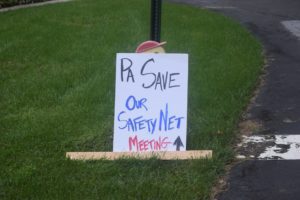PA Group Strives to Bust Myths About SNAP—and People Who Use It
Lisa Raditz cringes when she overhears some of the comments people make about SNAP recipients based on common myths and stereotypes. Raditz, who lives in the Philadelphia area, is currently receiving SNAP benefits and is painfully aware of the misconceptions about SNAP recipients, and the judgment people who use SNAP often face. “I’m caring for someone in my home who has mental health issues, so as a caretaker I’m eligible for SNAP and medical coverage. Without it, I wouldn’t have health insurance or food.”
The Supplemental Nutrition Assistance Program (SNAP), formerly known as the Food Stamp program, helps lower-income families buy groceries. Recipients use an Electronic Benefit Transfer (EBT) card to purchase approved grocery items. To be eligible for SNAP, a family’s gross monthly income currently cannot exceed 130 percent of the federal poverty level for the household size. However, the monthly allotment decreases as income increases, so the closer the household gets to reaching that monthly income limit, the lower their SNAP allotment will be.
Craig Robbins is a Community Organizer at the Philadelphia Unemployment Project, which is leading the Save Our Safety Net Campaign in Pennsylvania. Last month, the group held an event to celebrate SNAP’s “41st birthday,” and residents from throughout the area came to share their stories of how SNAP has been a lifesaver for them and their families. Robbins hopes events like these will help put a “face” on the issue, and show that SNAP recipients come from all backgrounds and all walks of life, and often find themselves facing struggles due to an unexpected, sudden change in circumstances. “Our goal is busting some of the myths about who the recipients are,” Robbins says.

Raditz met Robbins when she joined the Bucks County Save Our Safety Net group, and she’s been an active member of PUP ever since. “I get no cash,” Raditz notes. In addition to SNAP, she also receives Medicare, which she says is a blessing because she doesn’t have high copays or huge out-of-pocket expenses that would make it nearly impossible for her to receive medical care.
Despite suffering from an autoimmune condition, she works part-time, as allowed by SNAP regulations. “I work hard. I’m not lazy. But I could not afford insurance on my own, and there are no jobs I can get that provide insurance and would work with my caretaking schedule. Believe me, I’ve looked and tried to find them.”
Like many other SNAP recipients, Lisa found herself needing help after life threw her a few curveballs, mainly in the form of several health issues. “I never thought I’d be on it.”
Despite her challenges, Lisa says she is much better off than many others. She considers herself fortunate to have friends and family that make up a valuable support system. “Plus, I’m resourceful. I know how to look up information about programs and services.” She has sympathy for those who have to navigate the system on their own. “Many people don’t have anyone, and don’t have a support system.”
She serves as a caretaker to her companion, Mike, and has also become his dedicated advocate. “It took me years to fight for services for him. He worked for 25 years to earn these benefits. If I couldn’t care for him, he’d need to be hospitalized.”
SNAP funding and eligibility requirements are part of a huge piece of legislation known as the Farm Bill. Those issues were a big sticking point that kept Congress from agreeing on a final Farm Bill package this summer. The previous Farm Bill technically expired at the end of September, but programs like SNAP will keep running under the existing system for now until a new Farm Bill is passed.
Proposed changes to the SNAP program would include stricter work requirements and lower maximum income thresholds, meaning families would “max out” of SNAP eligibility sooner than they do now.
According to data tracked by the Pennsylvania Department of Human Services, more than 1.8 million Pennsylvanians are currently enrolled in the SNAP program. As of September, there were around 473,000 people in Philadelphia participating in SNAP, and nearly 38,000 people receiving SNAP benefits in Bucks County. Robbins noted that many of those Bucks County people live in the suburbs or more rural areas, where grocery shopping options may be more limited—making it even more challenging to stretch a limited food budget.
Mike is eligible to get supplies at a food bank. Lisa was there picking up his items when she heard about the Save Our Safety Net program. She wanted to get involved and share her story to help spread awareness about the critical need for the program. “I get $44 a week. You really have to plan well, and stretch it. It’s not enough for fresh vegetables or any extras. But it keeps us from starving. If they take SNAP away, it would be a crisis nobody wants to see. People wouldn’t be eating, and they’d be really desperate.”
Lisa admits she’s nervous about the proposed changes to SNAP, but tries not to think about it. “I’m a positive person, and I’m trying not to stress. The Save Our Safety Net program provides a way for people to be heard. I think we can make a difference if people tell their stories.”